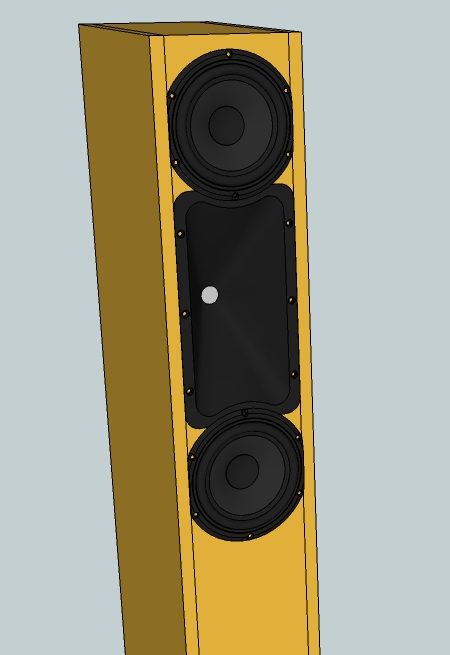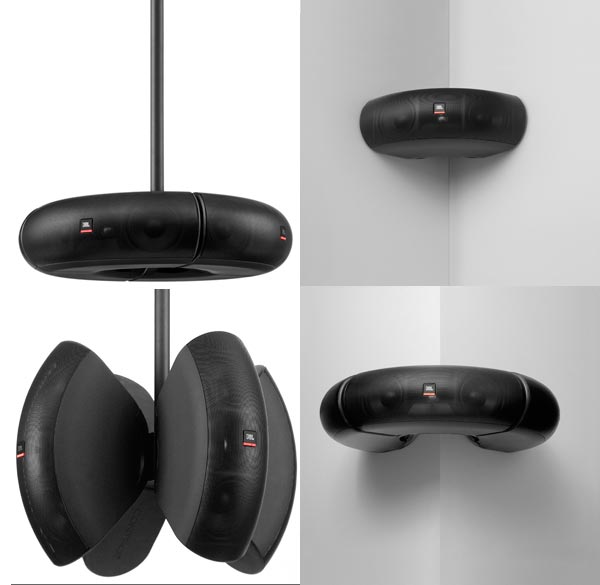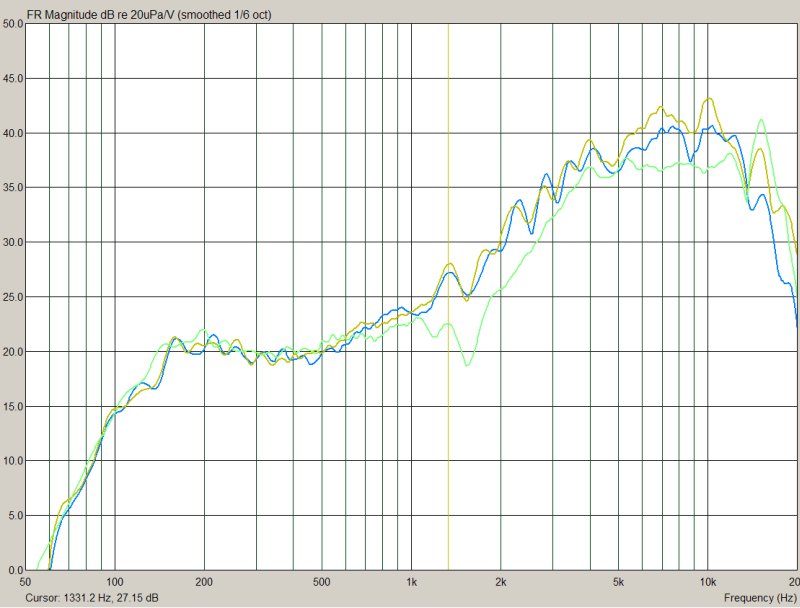Hello everyone,
I'm interested in using the Econowave horn (Pyle PH-612 and Selenium D220Ti) in a slim column speaker in a D'Appolito-Configuration with two Peerless SDS 6.5 woofers. Should give a decent efficiency of about 90-93 dB (depends on baffle step compensation). Crossover should be somewhere between 1k5 and 2k.
I want to mount the horn vertically and mount the woofers directly on the baffle (no flush mounting) and they shall cover the ends of the horn a little bit.

But: Is the vertical mounting of the PH-612 reasonable. I would expect an smaller sweet spot due to the significantly narrower dispersion of the tweeter, but this could be an advantage in acoustically bad rooms. I'm also expecting the problems with the not-perfect D'Appo to be less as the directivity of the horn will reduce the side lobes. This should result in a better controlled vertical dispersion.
Has anyone made experiences with vertically mounting horns or the effects of tweeter directivity on not-perfect D'Appos?
Bye,
Spatz
I'm interested in using the Econowave horn (Pyle PH-612 and Selenium D220Ti) in a slim column speaker in a D'Appolito-Configuration with two Peerless SDS 6.5 woofers. Should give a decent efficiency of about 90-93 dB (depends on baffle step compensation). Crossover should be somewhere between 1k5 and 2k.
I want to mount the horn vertically and mount the woofers directly on the baffle (no flush mounting) and they shall cover the ends of the horn a little bit.

But: Is the vertical mounting of the PH-612 reasonable. I would expect an smaller sweet spot due to the significantly narrower dispersion of the tweeter, but this could be an advantage in acoustically bad rooms. I'm also expecting the problems with the not-perfect D'Appo to be less as the directivity of the horn will reduce the side lobes. This should result in a better controlled vertical dispersion.
Has anyone made experiences with vertically mounting horns or the effects of tweeter directivity on not-perfect D'Appos?
Bye,
Spatz
Yep the distance between the woofers will likely be a problem. You would certainly be better with someting more like a sam1HF/2LF:
sam1hf / sam2lf
regarding putting the horn vertically, it is not a bad idea but you will not get a constant directivity:
the horn will loose pattern control under 2khz, so you will be in a so called "pattern flip" situation under that (very large dispersion).
So lets say you cut it around 800Hz (and even that would be too high if you want a d'appolito), the dispersion will be very high, and will gently narrow to the nominal 50° at around 2khz, be almost constant, and then gently narrow again starting around 10khz (due to the size of the driver).
The horizontal dispersion will be more like one of a direct radiator 2way, but the power response will be similar to a constant directivity speaker (because it is almost constant directivity in the 1000-10000 range in the vertical plan). Interesting mix!
that is similar to the JBL array 1400 (but the have a tweeter to enlarge the dispersion up high), and these speakers are made to be used with a center speaker in a HC situation. But then again, many like them in a stereo setup, even with the narrow horizontal dispersion.
sam1hf / sam2lf
regarding putting the horn vertically, it is not a bad idea but you will not get a constant directivity:
the horn will loose pattern control under 2khz, so you will be in a so called "pattern flip" situation under that (very large dispersion).
So lets say you cut it around 800Hz (and even that would be too high if you want a d'appolito), the dispersion will be very high, and will gently narrow to the nominal 50° at around 2khz, be almost constant, and then gently narrow again starting around 10khz (due to the size of the driver).
The horizontal dispersion will be more like one of a direct radiator 2way, but the power response will be similar to a constant directivity speaker (because it is almost constant directivity in the 1000-10000 range in the vertical plan). Interesting mix!
that is similar to the JBL array 1400 (but the have a tweeter to enlarge the dispersion up high), and these speakers are made to be used with a center speaker in a HC situation. But then again, many like them in a stereo setup, even with the narrow horizontal dispersion.
Last edited:
I know that the vertical dispersion with this position of the woofers won't be perfect at all. But: There is almost no real D'Appolito and yet this concept is very famous. Plus I want to use the additional vertical directivity to reduce reflections with ceiling and floor.
The vertical (when mounted as usual) loss in pattern control is IMHO no problem, as a crossover point where the woofers are not yet beaming horizontally is possible. The additional control in the vertical plane should be suitable to the woofers' positions.
What do you think?
The vertical (when mounted as usual) loss in pattern control is IMHO no problem, as a crossover point where the woofers are not yet beaming horizontally is possible. The additional control in the vertical plane should be suitable to the woofers' positions.
What do you think?
that is similar to the JBL array 1400 (but the have a tweeter to enlarge the dispersion up high), and these speakers are made to be used with a center speaker in a HC situation. But then again, many like them in a stereo setup, even with the narrow horizontal dispersion.
They are not as narrow as you think. The large horns are 80x80 and the UHF is 30x60. The UHF horn is what defines the placement for this system. The UHF horn does help maintaing dispersion in the upper octave at the expense of a narrow verticle axis.
Rob
Rob, as you know the 1400 array horn is directly derived from the H4338, which is a 90x50 horn. I have seen measurement of the 1400 directivity on a french forum (will try to find them...), and it was what was get... above 1500Hz. Under that the horn was loosing pattern control in its smaller dimension, which is normal. I guess the 80° figure is an average over the entier range of the horn.
I have measured my H9800 clones (quite similar to the H4338) and the same phenomenon can be observed.
In my view the 1400 array in an interesting speaker in that you get the directivity characteristic of a cone speaker, but the power response of a constant directivity horn system.
I have measured my H9800 clones (quite similar to the H4338) and the same phenomenon can be observed.
In my view the 1400 array in an interesting speaker in that you get the directivity characteristic of a cone speaker, but the power response of a constant directivity horn system.
Hello everyone,
I'm interested in using the Econowave horn (Pyle PH-612 and Selenium D220Ti) in a slim column speaker in a D'Appolito-Configuration with two Peerless SDS 6.5 woofers. Should give a decent efficiency of about 90-93 dB (depends on baffle step compensation). Crossover should be somewhere between 1k5 and 2k.
I want to mount the horn vertically and mount the woofers directly on the baffle (no flush mounting) and they shall cover the ends of the horn a little bit.

But: Is the vertical mounting of the PH-612 reasonable. I would expect an smaller sweet spot due to the significantly narrower dispersion of the tweeter, but this could be an advantage in acoustically bad rooms. I'm also expecting the problems with the not-perfect D'Appo to be less as the directivity of the horn will reduce the side lobes. This should result in a better controlled vertical dispersion.
Has anyone made experiences with vertically mounting horns or the effects of tweeter directivity on not-perfect D'Appos?
Bye,
Spatz
A lot of speakers with waveguides use a crossover point designed to match the directivity of the low frequency driver and waveguide. For instance, the Gedlee Summas have a crossover around 900hz, because that's where the directivity of the waveguide collapses. With a 6.5" waveguide, you'd be looking at a crossover point of 2076hz.
This is "do-able" with your woofer choice, because the Peerless should be able to reach up to 2khz, and the waveguide can certainly play that low.
The tricky part is that the dual woofers creates a very strong forward lobe, due to their spacing.
But that doesn't mean your design won't work.
The easiest solution is to do this as a 2.5 way design. Basically stagger the crossover points, so that only one woofer is playing from 1khz to 2khz. That will reduce the forward lobe that's created by the array of dual woofers.

Another option is to flip the speaker ninety degrees. JBL did this with their "Control Now" array.
I've measured it, and the results were amazing. It basically works like a very efficient coaxial, and it's a helluva design.
HTH.
The crossover point could be even lower I suppose. According to those measurements the horn is loading down to 1k, but vertically the directivity collapses below 2k, so below 2k the tweeter is radiating omnipolar, at least in the vertical plane. Horizontally the directivity goes down to 1k, which should help with the lobe produced by the woofers.
I heard that such a lobe should result in a more direct sound, as all kind of higher directivity does. So this speaker should produce some kind of "in-your-face"-sound with little room interaction. Could be good, what do you think?
2,5 ways should reduce that effect, but I think I'd prefer that sounding of a two way system. If I should build that prototype (I don't know where to get that driver/horn in Germany) I'll try both configs, but I think the 2 way will sound better...
Do you have further information/measurements on that JBL thingy, that looks interesting! No problems with the vertical D'Appo?
Bye,
Spatz
I heard that such a lobe should result in a more direct sound, as all kind of higher directivity does. So this speaker should produce some kind of "in-your-face"-sound with little room interaction. Could be good, what do you think?
2,5 ways should reduce that effect, but I think I'd prefer that sounding of a two way system. If I should build that prototype (I don't know where to get that driver/horn in Germany) I'll try both configs, but I think the 2 way will sound better...
Do you have further information/measurements on that JBL thingy, that looks interesting! No problems with the vertical D'Appo?
Bye,
Spatz
The crossover point could be even lower I suppose. According to those measurements the horn is loading down to 1k, but vertically the directivity collapses below 2k, so below 2k the tweeter is radiating omnipolar, at least in the vertical plane. Horizontally the directivity goes down to 1k, which should help with the lobe produced by the woofers.
I heard that such a lobe should result in a more direct sound, as all kind of higher directivity does. So this speaker should produce some kind of "in-your-face"-sound with little room interaction. Could be good, what do you think?
2,5 ways should reduce that effect, but I think I'd prefer that sounding of a two way system. If I should build that prototype (I don't know where to get that driver/horn in Germany) I'll try both configs, but I think the 2 way will sound better...
Do you have further information/measurements on that JBL thingy, that looks interesting! No problems with the vertical D'Appo?
Bye,
Spatz
The JBL curved array is an impressive bit of engineering.
Here's what I *think* is going on. This is a bit of a guess, so bear with me.

Here's the polar response on and off axis, which I measured.
See how it's very hot in the top octaves?
I think what's going on is that it's designed to use a wall to reinforce the lower frequencies. The array is about 16" in diameter. At that size, it will begin to go omnipolar at 844hz. But back the array into a corner, and the walls will reinforce it's response all the way down to 40hz, if not deeper.
Kind of a clever trick no?
Of course, any ol' bookshelf can do the same trick. But the JBL seems to be very carefully designed so that all three voice coils are lined up, which will improve it's off-axis response. And the shape of the cabinet makes it easier to array. And tilting the woofers off axis will reduce interference, minimizing the downsides of a horizontal array.
All in all, lots of good engineering here.
I posted more info on it here:
Audio Psychosis • View topic - Fifty Dollar Speaker Review
But back the array into a corner, and the walls will reinforce it's response all the way down to 40hz, if not deeper.
But 20dB worth? More like 4 to 5dB, leaving a 15dB treble shelf. Even 4 units in a ring will not add up to flat.
David
I think what's going on is that it's designed to use a wall to reinforce the lower frequencies. The array is about 16" in diameter. At that size, it will begin to go omnipolar at 844hz. But back the array into a corner, and the walls will reinforce it's response all the way down to 40hz, if not deeper.
Hi Patrick,
You may be interested to look at JBL's measurements for the Control CRV, which is basically the same speaker with a different impedance and the built-in transformer, as far as I can tell. All the other specs seem to be the same.
http://www.jblpro.com/catalog/support/getfile.aspx?doctype=3&docid=1388
Home Theater Magazine measured them here: JBL Control NOW AW Speaker System HT Labs Measures | Home Theater
I have a pair that I'm planning to use as the surrounds for my JBL Array 1400/800 main channels.
Young-Ho
Rob, as you know the 1400 array horn is directly derived from the H4338, which is a 90x50 horn.
Hello Pos
They are the same family, biradial, that doesn't make them the same horn. There are dimensional differences in height, depth, and actual horn contours. The 80X80 is out of the SAMHF specsheet. Have you heard a pair?
Rob
Hi Rob
I have heard the 1400 array, but never the SAM1HF. I think this is the exact same horn, isn't it?
I though the Greg Timbers' array prototypes where using H4338 (with only the minor modification of the additional UHF horn), no? I always understood this that way when reading Giskard's comments and networks discussions.
I have heard the 1400 array, but never the SAM1HF. I think this is the exact same horn, isn't it?
I though the Greg Timbers' array prototypes where using H4338 (with only the minor modification of the additional UHF horn), no? I always understood this that way when reading Giskard's comments and networks discussions.
- Status
- This old topic is closed. If you want to reopen this topic, contact a moderator using the "Report Post" button.
- Home
- Loudspeakers
- Multi-Way
- Vertical mount of Econowave horn